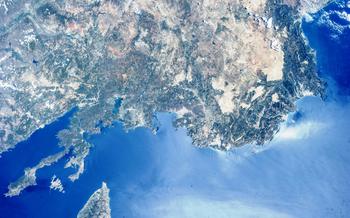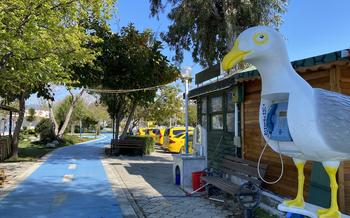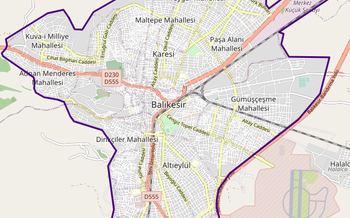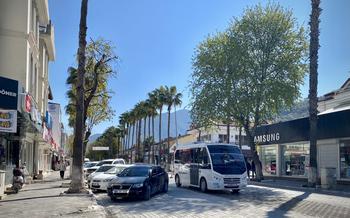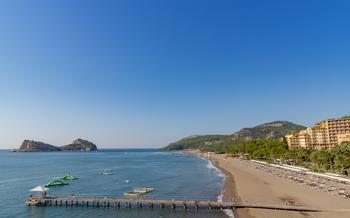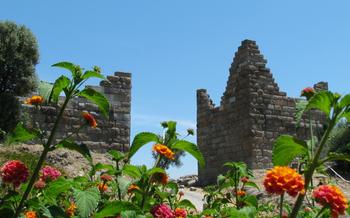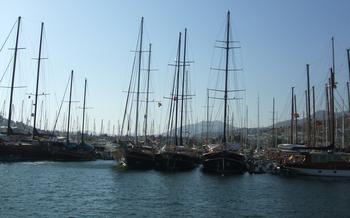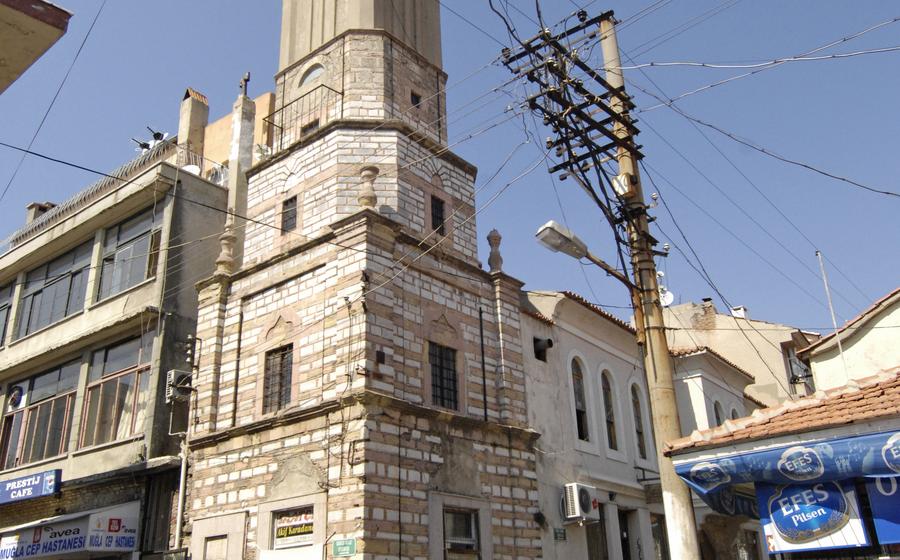
Euromos Temple of Zeus
- The Euromos Temple of Zeus: A Historical Gem
- A Journey Through Time: Exploring the Ruins
- A Majestic Figure: The Statue of Zeus
- Uncovering the Secrets: Archaeological Discoveries
- A Glimpse into Ancient Rituals: The Altar
- The Surrounding Landscape: A Natural Canvas
- A Photographer's Paradise: Capturing the Beauty
- Euromos Village: A Touch of Local Charm
- Transportation Tips: Getting to the Temple
- Hours of Operation and Ticket Information
- Dress Appropriately: Respecting the Sacred Site
- Be Prepared for the Weather: Sunscreen and Water
- Exploring Nearby Sites: Ancient Theaters
- Insider Tip: Capture the Sunset Magic
The Euromos Temple of Zeus: A Historical Gem
In the heart of Muğla, Turkey, lies a testament to ancient Greek grandeur: the Euromos Temple of Zeus. This iconic site, steeped in history and mythology, invites visitors to embark on a journey through time and discover the secrets of a bygone era. Built atop a hill overlooking the picturesque Euromos village, the temple stands as a symbol of the region's rich cultural heritage and offers a glimpse into the lives and beliefs of ancient Greek civilizations.
Historical Significance
Constructed in the 3rd century BC, the Euromos Temple of Zeus served as a central place of worship for the ancient city of Euromos. Dedicated to the mighty god Zeus, the temple was considered one of the most important religious sites in the region. Zeus, revered as the king of the gods in Greek mythology, was associated with thunder, lightning, and the heavens, making this temple a sacred and powerful sanctuary.
Architectural Features
The temple's architectural design reflects the grandeur and sophistication of ancient Greek architecture. Constructed from local limestone, the temple features a rectangular layout with a series of columns lining its perimeter. These imposing columns, known as Doric columns, are characterized by their simple yet elegant design, adding to the temple's majestic appearance.
Location and Accessibility
The Euromos Temple of Zeus is situated approximately 40 kilometers southwest of Muğla city center. Easily accessible by car or guided tour, the temple is nestled amidst a serene landscape of olive groves and pine forests, offering visitors a tranquil and picturesque setting to explore this ancient wonder.
A Journey Through Time: Exploring the Ruins
The ancient city of Euromos, where the temple stands, invites visitors on a captivating journey through time. As you wander amidst the well-preserved ruins, you'll encounter remnants of walls, foundations, and columns that once formed the bustling streets and buildings of this ancient metropolis. The structures, remarkably intact, provide a tangible connection to the past, allowing you to envision the daily lives of the people who inhabited this city centuries ago.
Let your imagination soar as you picture the bustling marketplace, the lively conversations in the tavernas, and the solemn rituals conducted within the temple. The Euromos Temple of Zeus is not merely a historical site; it's a gateway to a bygone era, where you can feel the echoes of ancient footsteps and witness the grandeur of a civilization that left an indelible mark on history.
A Majestic Figure: The Statue of Zeus
The Euromos Temple of Zeus would have housed a colossal statue of the mighty god, crafted with exquisite skill and precision. While the statue itself has not survived the relentless passage of time, historians and archaeologists have meticulously pieced together its grandeur through various accounts and descriptions.
Standing at an awe-inspiring height, the statue of Zeus exuded an aura of power and majesty. Its imposing size commanded attention, symbolizing the god's dominion over the heavens and the earth. The skilled artisans who created this masterpiece used marble or bronze as their medium, breathing life into the divine form.
The statue's features were meticulously carved, capturing the essence of Zeus's godhood. His piercing gaze, etched with wisdom and authority, held the power to command thunder and lightning. His muscular physique, sculpted with intricate detail, conveyed his unrivaled strength and virility.
Beyond its physical attributes, the statue of Zeus held immense religious significance. It served as a tangible representation of the god, allowing worshippers to feel a tangible connection to the divine. Ancient Greeks would flock to the temple, seeking blessings, guidance, and protection from the king of the gods.
Myths and legends intertwined with the statue's existence, adding layers of intrigue and fascination. Zeus, the god of thunder and lightning, was said to have wielded his mighty thunderbolt from atop Mount Olympus, striking fear into the hearts of mortals and immortals alike. His presence in Euromos, through the towering statue, further cemented his status as the supreme deity of the Greek pantheon.
Uncovering the Secrets: Archaeological Discoveries
Excavations at the Euromos Temple of Zeus continue to reveal fascinating insights into ancient Greek culture and religious practices. Archaeologists have unearthed a wealth of artifacts, including pottery fragments, coins, and jewelry, which provide glimpses into the daily lives of the people who worshipped at this sacred site.
One remarkable discovery was a well-preserved statue of a bull, believed to be an offering to Zeus, who was often associated with fertility and strength. This statue and other findings suggest that the temple may have been used for agricultural rituals and celebrations in addition to religious ceremonies.
The ongoing excavations continue to shed light on the importance of the temple and its role within the ancient city of Euromos. As archaeologists carefully uncover each layer of history, they bring us closer to understanding the beliefs and practices of this ancient civilization.
A Glimpse into Ancient Rituals: The Altar
At the heart of the Euromos Temple of Zeus lies the altar, a sacred structure that holds immense significance in understanding ancient Greek religious practices. Situated prominently in front of the temple, the altar served as a focal point for rituals and ceremonies honoring the mighty god Zeus.
The Location and Significance of the Altar: The altar occupies a central position within the temple complex, underscoring its pivotal role in religious ceremonies. Its placement directly in front of the temple's entrance emphasizes its importance as the primary site for offerings and sacrifices made to Zeus.
Rituals and Ceremonies Performed: The altar witnessed various rituals and ceremonies conducted by priests and worshippers. Animal sacrifices were a common practice, with offerings made to Zeus in exchange for his favor and protection. The altar served as a sacred platform where the sacrificial animals were slaughtered and their remains burned as an offering to the deity.
Connection to Religious Practices: The altar's significance extends beyond individual acts of devotion. It represents the deep connection between the ancient Greeks and their gods. Through rituals performed at the altar, the community expressed its gratitude, sought divine intervention, and celebrated religious festivals honoring Zeus.
The Surrounding Landscape: A Natural Canvas
The Euromos Temple of Zeus is not just confined to its architectural wonders; it is also surrounded by a breathtaking natural canvas that paints a picturesque backdrop for the site. As you approach the temple, you will be greeted by an expanse of olive groves and pine forests, adding a touch of greenery and serenity to the surroundings. The contrast between the ancient ruins and the lush vegetation creates a harmonious blend of history and nature.
Embark on a hiking adventure through the nearby trails that meander through the verdant forests and offer panoramic views of the valley. The fresh air, coupled with the chirping of birds and the rustling of leaves, creates a symphony of nature that enhances the overall experience. As you wander through the trails, keep an eye out for local flora and fauna, adding an element of discovery to your journey.
A Photographer's Paradise: Capturing the Beauty
The Euromos Temple of Zeus presents a captivating subject for photographers of all skill levels. The interplay of natural and historical elements creates a picturesque canvas that begs to be captured.
Golden Hour Photography:
The golden hour, that magical period just after sunrise or before sunset, casts a warm, golden glow on the ruins, enhancing their grandeur. This is the ideal time to capture the temple's majesty and the surrounding landscape.
Panoramic Shots:
The temple's commanding position on a hilltop offers panoramic views of the countryside. Photographers can capture breathtaking shots encompassing the temple, the ancient city, the olive groves, and the distant mountains.
Unique Perspectives:
Exploring the ruins from different angles reveals hidden details and unique perspectives. Wander among the fallen columns, peer into the temple's interior, or climb to higher ground for a bird's-eye view. Experiment with different vantage points to create striking compositions.
Whether you're a seasoned professional or an amateur with a passion for photography, the Euromos Temple of Zeus promises an unforgettable experience. Embrace your creativity and let your lens tell the story of this ancient wonder.
Euromos Village: A Touch of Local Charm
Nestled amidst the serene landscape that surrounds the Euromos Temple of Zeus, the picturesque village of Euromos beckons visitors with its timeless charm. As you approach the village, you'll be greeted by an array of traditional stone houses, each adorned with intricate details that speak of a rich cultural heritage. The narrow cobblestone streets invite you to wander aimlessly, discovering hidden corners and charming shops that line the way.
The heart of Euromos lies in its central square, where locals gather to sip Turkish coffee, share stories, and welcome visitors with open arms. Indulge in the delectable aromas wafting from local eateries, where you can savor authentic Turkish cuisine prepared with fresh, local ingredients. Experience the warmth and hospitality of the villagers as they share tales of their ancestors and the enduring traditions that have shaped the village's identity.
Take the time to explore the village's surroundings, where olive groves and pine forests paint a vibrant tapestry of nature. Embark on leisurely hikes or bike rides along scenic trails that lead you to breathtaking viewpoints, offering panoramic vistas of the countryside and the sparkling Aegean Sea beyond.
Euromos is a living testament to the harmonious coexistence of ancient history and modern-day life. As you wander through its streets, you'll feel a sense of tranquility and connection to the past, making it the perfect destination to unwind and immerse yourself in the authentic charm of rural Turkey.
Transportation Tips: Getting to the Temple
Reaching the Euromos Temple of Zeus is a breeze, with various transportation options available to suit your preferences. For those who prefer public transportation, buses and minibuses frequently travel from Muğla and neighboring towns, making stops near the temple. However, if you seek the freedom to explore at your own pace, consider renting a car. This option allows you to set your own itinerary and make spontaneous stops along the way. Additionally, guided tours are available, providing a hassle-free experience with knowledgeable guides sharing insights into the temple's history and significance. Whichever mode of transportation you choose, getting to the temple is convenient and straightforward.
Hours of Operation and Ticket Information
To plan your visit to the Euromos Temple of Zeus effectively, it is crucial to be aware of its operating hours and ticket information. The temple is generally open to the public seven days a week, allowing for flexible scheduling. However, it is advisable to check the official website or contact local tourism authorities for any updates or changes in the operating hours.
Ticket prices for entry to the temple are set to ensure accessibility while preserving the site's historical significance. General admission tickets are typically available at a reasonable cost, and there may be reduced rates for students, seniors, or families. Keep an eye out for special promotions or discounts offered during certain periods or events.
To make the most of your visit, it is recommended to allocate at least one to two hours for exploring the temple and its surroundings. This will provide ample time to admire the architectural details, immerse yourself in the history, and capture some memorable photographs. Remember to arrive early or visit during off-peak hours to avoid crowds and fully appreciate the serenity of the site.
Dress Appropriately: Respecting the Sacred Site
As you embark on your journey to the Euromos Temple of Zeus, it is essential to dress respectfully, honoring the religious significance of this sacred site. Modest attire is recommended, ensuring that your clothing covers your shoulders and knees. Avoid revealing or transparent garments that may be deemed inappropriate in this spiritual setting. By adhering to these guidelines, you not only show respect for the temple's religious history but also contribute to preserving its sacred atmosphere for future generations. Remember, cultural sensitivity is key when visiting religious sites, and dressing appropriately is a simple yet meaningful way to demonstrate your respect and appreciation. Embrace the opportunity to immerse yourself in the temple's ancient aura while maintaining a sense of reverence for its sacredness.
Be Prepared for the Weather: Sunscreen and Water
The Mediterranean sun can be quite intense in Turkey, especially during the summer months. It's essential to be prepared for the weather when visiting the Euromos Temple of Zeus. Sunscreen with a high SPF is a must to protect your skin from harmful UV rays. Wearing a hat and sunglasses will further shield you from the sun's glare.
Staying hydrated is crucial when exploring ancient sites in Turkey. Carry a reusable water bottle and refill it whenever possible. There are no water fountains or cafes near the temple, so it's best to come prepared. Remember, dehydration can quickly lead to fatigue and discomfort, especially in hot weather.
By taking these simple precautions, you can ensure a comfortable and enjoyable visit to the Euromos Temple of Zeus. Don't let the sun and heat spoil your experience of this remarkable historical site.
Exploring Nearby Sites: Ancient Theaters
The Euromos Temple of Zeus is not the only ancient marvel in the region. A short distance away, you can immerse yourself in the world of ancient Greek theater at one of the many well-preserved theaters in the area. These theaters, once the epicenters of entertainment and storytelling, have stood the test of time and continue to captivate visitors with their grandeur.
The most renowned of these theaters is the Knidos Ancient Theater, situated approximately 40 kilometers from the temple. Built in the 4th century BC, this impressive structure could accommodate up to 20,000 spectators and hosted a variety of performances, from plays and concerts to religious ceremonies. Its remarkably preserved stage, adorned with intricate carvings and sculptures, transports visitors back in time to the era of ancient Greek drama.
But the Knidos Ancient Theater is just one of many in the region. The ancient city of Kaunos, located about 25 kilometers away, boasts its own theater, smaller in size but equally impressive in its architecture. With a seating capacity of around 5,000, the Kaunos Ancient Theater was a vibrant hub for cultural events and performances.
These ancient theaters are not mere historical relics; they are living testaments to the rich cultural heritage of the region. Some of them still host performances and events, allowing visitors to experience the magic of ancient Greek theater firsthand. Imagine sitting in the very seats where audiences centuries ago were enthralled by the works of Sophocles, Euripides, and Aristophanes.
Whether you choose to visit the Knidos Ancient Theater, the Kaunos Ancient Theater, or any of the other nearby theaters, you'll be treated to an unforgettable journey through time, where history, culture, and entertainment converge to create a truly immersive experience.
Insider Tip: Capture the Sunset Magic
As the sun begins its descent, painting the sky in hues of orange, pink, and purple, the Euromos Temple of Zeus transforms into a magical spectacle. The ancient ruins, bathed in the warm glow of the setting sun, cast long shadows that dance across the landscape, creating an ethereal and awe-inspiring atmosphere. This is the perfect time to capture the beauty of the site through photography.
Set up your tripod and camera, ensuring a stable shot, and wait for the perfect moment. As the sun dips below the horizon, the sky erupts in a vibrant display of colors, reflecting off the weathered stones of the temple. Experiment with different shutter speeds to capture the movement of the clouds and create a sense of dynamism in your images.
Don't forget to explore different angles and perspectives. Climb to a higher vantage point to capture a panoramic shot that encompasses the temple, the surrounding landscape, and the vibrant sky. Alternatively, get down low to capture close-up details of the intricate carvings and architectural features, allowing the warm light to illuminate the textures and patterns.
Whether you're a seasoned photographer or a casual enthusiast, the sunset at the Euromos Temple of Zeus is a sight to behold. Embrace the magic of the moment, capture the beauty of the ancient ruins, and create unforgettable memories that will last a lifetime.
